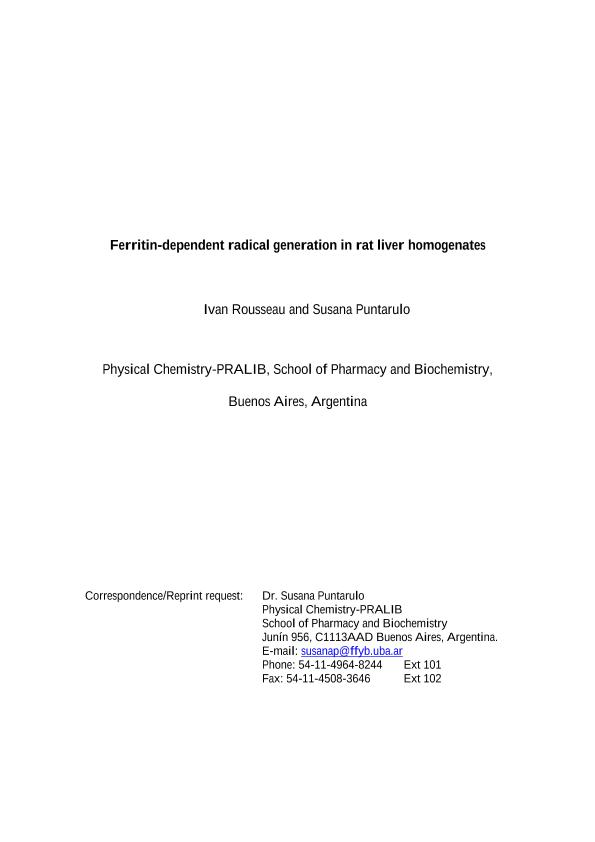Mostrar el registro sencillo del ítem
dc.contributor.author
Rousseau, Iván

dc.contributor.author
Puntarulo, Susana Ángela

dc.date.available
2020-04-16T14:41:12Z
dc.date.issued
2009-10
dc.identifier.citation
Rousseau, Iván; Puntarulo, Susana Ángela; Ferritin-dependent radical generation in rat liver homogenates; Elsevier Ireland; Toxicology; 264; 3; 10-2009; 155-161
dc.identifier.issn
0300-483X
dc.identifier.uri
http://hdl.handle.net/11336/102723
dc.description.abstract
The hypothesis of this study was that mammalian ferritin (FER) has the ability of releasing Fe in the tissue to catalyze the generation of free radicals, such as ascorbyl (A) and hydroxyl radical (OH), that might lead to the damage of FER itself. The rat liver homogenates exhibited an electron paramagnetic resonance (EPR) signal with the spectral features (a(H)=1.88 G, g=2.0054) of A. The addition to the reaction medium of isolated rat liver FER increased by 3-fold the EPR signal, as compared to the recorded value in its absence. Isolated microsomes from rat liver incubated during 10 min showed a signal with the spectral features (a(H)=15G, g=2.0062) of OH. The addition of FER in the presence of either ethylenediamine-tetraacetic acid (EDTA) or adenosine-5'-triphosphate (ATP) significantly increased the recorded spectra. The labile Fe pool (LIP) in the homogenate was assessed by EPR. The rat liver homogenates exhibited an EPR signal with the spectral features (g=4.3) of the Fe(2+) and was significantly increased by the addition of FER (3-fold). The oxidation profile of the isolated FER from rat liver was analyzed after incubation with 10 mM ascorbate (AH(-)). A drastic increase in the width of the band suggested alterations to the protein structure. The FER content of tryptophan (Trp) and thiols was significantly lower when the incubation was performed in the presence of AH(-) as compared to the recorded effect in its absence. The data in tissue homogenates presented here showed that radical generation is associated to FER Fe release, and moreover that the FER protein itself was affected during this process.
dc.format
application/pdf
dc.language.iso
eng
dc.publisher
Elsevier Ireland

dc.rights
info:eu-repo/semantics/openAccess
dc.rights.uri
https://creativecommons.org/licenses/by-nc-sa/2.5/ar/
dc.subject
FERRITIN
dc.subject
LABILE IRON POOL
dc.subject
FREE RADICAL
dc.subject.classification
Biología Reproductiva

dc.subject.classification
Ciencias Biológicas

dc.subject.classification
CIENCIAS NATURALES Y EXACTAS

dc.title
Ferritin-dependent radical generation in rat liver homogenates
dc.type
info:eu-repo/semantics/article
dc.type
info:ar-repo/semantics/artículo
dc.type
info:eu-repo/semantics/publishedVersion
dc.date.updated
2020-04-14T13:36:35Z
dc.journal.volume
264
dc.journal.number
3
dc.journal.pagination
155-161
dc.journal.pais
Irlanda

dc.description.fil
Fil: Rousseau, Iván. Consejo Nacional de Investigaciones Científicas y Técnicas. Oficina de Coordinación Administrativa Houssay. Programa de Radicales Libres; Argentina. Universidad de Buenos Aires. Facultad de Farmacia y Bioquímica; Argentina
dc.description.fil
Fil: Puntarulo, Susana Ángela. Universidad de Buenos Aires. Facultad de Farmacia y Bioquímica; Argentina. Consejo Nacional de Investigaciones Científicas y Técnicas. Oficina de Coordinación Administrativa Houssay. Programa de Radicales Libres; Argentina. Consejo Nacional de Investigaciones Científicas y Técnicas; Argentina
dc.journal.title
Toxicology

dc.relation.alternativeid
info:eu-repo/semantics/altIdentifier/url/http://www.journals.elsevier.com/toxicology
dc.relation.alternativeid
info:eu-repo/semantics/altIdentifier/doi/https://doi.org/10.1016/j.tox.2009.07.019
Archivos asociados
